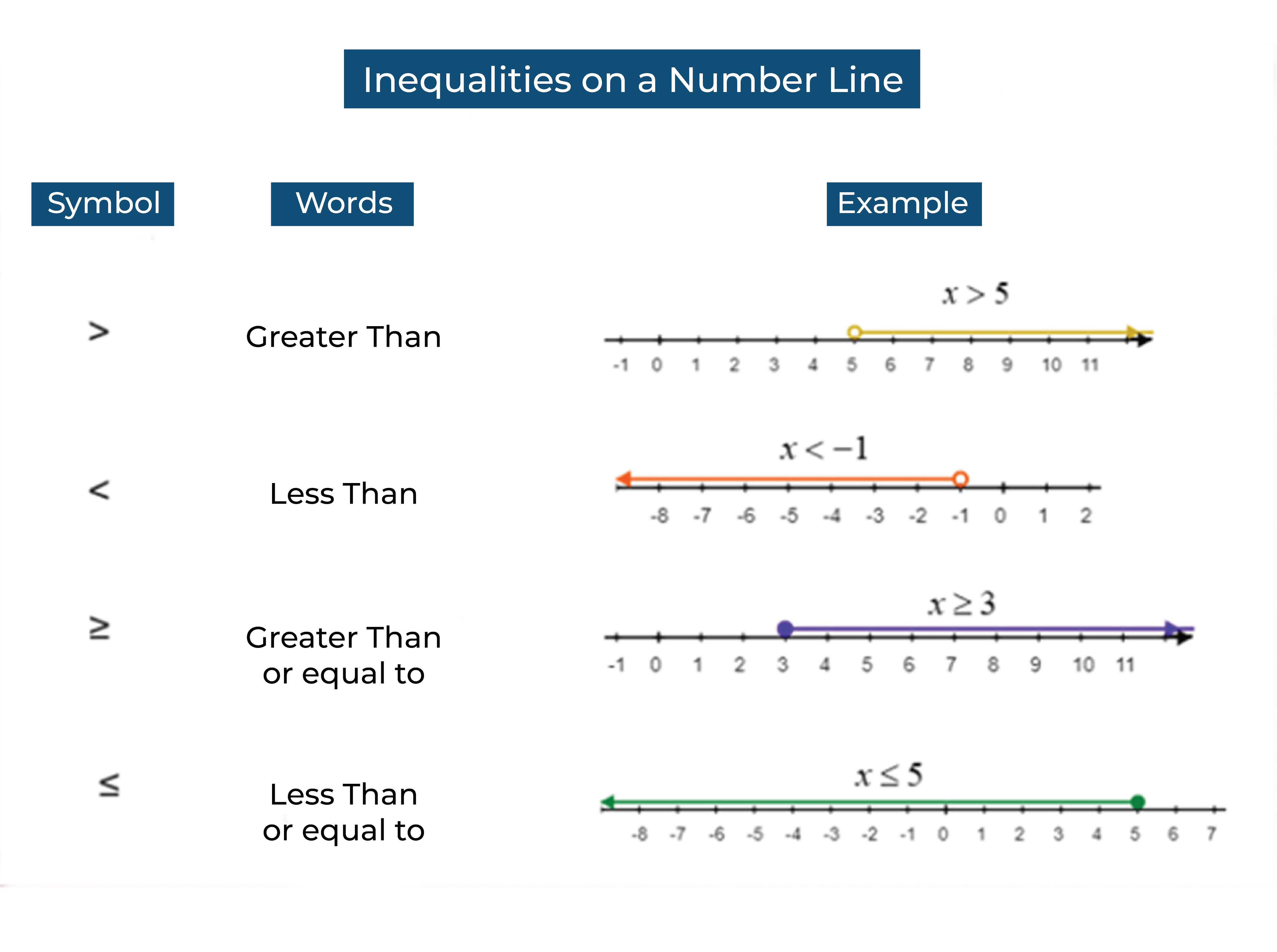Solution Set for Inequalities
Grade 6 Math Worksheets
An inequality is a mathematical statement that compares two expressions using one of the following symbols: <, >, ≤, ≥, ≠. For example, 2x + 3 > 5 is an inequality.
Solution Set for Inequalities - Grade 6 Math Worksheet PDF
This is a free printable / downloadable PDF worksheet with practice problems and answers. You can also work on it online.
|
|
Untimed |
|
Sign up with your email ID to access this free worksheet.
"We really love eTutorWorld!"
"We really love etutorworld!. Anand S and Pooja are excellent math teachers and are quick to respond with requests to tutor on any math topic!" - Kieran Y (via TrustSpot.io)
"My daughter gets distracted easily"
"My daughter gets distracted very easily and Ms. Medini and other teachers were patient with her and redirected her back to the courses.
With the help of Etutorworld, my daughter has been now selected in the Gifted and Talented Program for the school district"
- Nivea Sharma (via TrustSpot.io)
Inequalities are important in real-life problems because they allow us to model situations where the exact value of a variable is not known, but we know that it falls within a certain range. For example, in finance, inequalities can be used to determine the range of possible profits or losses for a given investment. In engineering, inequalities can be used to determine the range of possible stress or strain on a structure.
The solution set for an inequality is the set of all values that make the inequality true. For example, the solution set for the inequality 2x + 3 > 5 is all real numbers x such that x > 1. The solution set for an inequality can be represented graphically on a number line. A closed dot is used to represent a value that is included in the solution set, and an open dot is used to represent a value that is not included.
Solving inequalities can be done by using algebraic techniques such as adding, subtracting, multiplying, or dividing both sides of the inequality by the same value, but you must always remember to reverse the inequality sign if you multiply or divide by a negative value.
It’s important to note that solution set of an inequality is not a single number. It’s a set of all possible values that satisfy the inequality.
Solution Set for Inequalities
A solution set is the set of all values that make an inequality true. For example, the solution set for the inequality x > 2 is all the numbers greater than 2.
First, simplify the inequality by combining like terms and solving for the variable to find the solution set for an inequality. Next, graph the inequality on a number line by using an open or closed dot to represent the inequality symbol. An open dot represents “greater than” or “less than” and a closed dot represents “greater than or equal to” or “less than or equal to”. Finally, shade the region of the number line that represents the solution set.
For example, to find the solution set for the inequality x > 2, first, solve for x. Next, graph the inequality on a number line using an open dot at 2 and shading the region to the right of 2. The solution set for this inequality is all the numbers greater than 2.
How to represent the solution set for an inequality
Solution sets can be represented in several ways, such as interval notation and set builder notation.

Interval notation is a way of representing a solution set using brackets and/or parentheses. Brackets are used to represent “greater than or equal to” or “less than or equal to”, while parentheses are used to represent “greater than” or “less than”.
For example, the solution set for the inequality x > 2 can be represented in interval notation as (2, infinity). The parenthesis indicates that the solution set does not include 2.
Set builder notation is another way to represent a solution set. It uses the set notation, where a set of values is defined by a rule or condition.
For example, the solution set for the inequality x > 2 can be represented in set builder notation as {x|x > 2}. The vertical line separates the values that belong to the set from the rule or condition that defines them.
“There have been times when we booked them last minute, but the teachers have been extremely well-prepared and the help desk at etutorworld is very prompt.
Our kid is doing much better with a higher score.”
6th Grade Tutoring
eTutorWorld offers Personalized Online Tutoring for Math, Science, English, and Standardised Tests.
Our Tutoring Packs start at just under $22.49 per hour, and come with a moneyback guarantee.
Schedule a FREE Trial Session, and experience quality tutoring for yourself. (No credit card required.)
How to find the solution set for a compound inequality?
A compound inequality is an inequality that contains two or more inequality statements. To find the solution set for a compound inequality, we need to solve each inequality statement separately and then combine the solutions.
For example, to find the solution set for the compound inequality 2 < x < 5, we first solve for x in 2 < x to get x > 2. Next, we solve for x in x < 5 to get x < 5. The solution set for this compound inequality is all the numbers greater than 2 and less than 5, which can be represented in interval notation as (2,5) or in set builder notation as {x|2<x<5}.
Another example, Erin packed a backpack for a camping trip. The instructions on Erin’s backpack say the backpack must weigh less than 25 pounds when packed. Erin will be packing a 5-pound cooking kit and other supplies. Which inequality best describes the weight in pounds of Erin’s backpack after she packs it?
Answer will be 5<w<25
Real-life Applications of Inequalities and Solution Sets
Inequalities are used in many fields such as economics, finance, engineering, and many more. For example:
In economics, inequalities can be used to model the distribution of income or wealth.
In finance, inequalities can be used to model the rate of return on an investment.
In engineering, inequalities can be used to model the strength of materials.
Do You Stack Up Against the Best?
If you have 30 minutes, try our free diagnostics test and assess your skills.
Solution Set for Inequalities FAQS
What is a solution set for an inequality?
A solution set for an inequality is the set of all possible values that make the inequality true. For example, if the inequality is “x > 5”, the solution set would be all the numbers greater than 5, including 5.1, 5.5, 6, 7, and so on.
How do you find the solution set for an inequality?
To find the solution set for an inequality, you need to figure out which values of the variable make the inequality true. One way to do this is to plug in different values for the variable and see if they satisfy the inequality. Another way is to graph the inequality on a number line and shade in the region that represents the solution set.
What is the difference between an equation and an inequality?
An equation is a statement that two expressions are equal, while an inequality is a statement that two expressions are not equal. In other words, an equation tells you that two things are the same, while an inequality tells you that they are different.
What are some examples of inequalities?
Some examples of inequalities include “x > 3” (x is greater than 3), “y < 2” (y is less than 2), “z >= 5” (z is greater than or equal to 5), and “w <= -1” (w is less than or equal to -1).
Why is it important to understand solution sets for inequalities?
Understanding solution sets for inequalities is important in many areas of math, including algebra, geometry, and calculus. It is also important in everyday life, such as when calculating budgets, comparing prices, or solving problems that involve variables and constraints. By understanding solution sets, you can make informed decisions and solve a variety of real-world problems.

Gloria Mathew writes on math topics for K-12. A trained writer and communicator, she makes math accessible and understandable to students at all levels. Her ability to explain complex math concepts with easy to understand examples helps students master math. LinkedIn
Affordable Tutoring Now Starts at Just $22.49
eTutorWorld offers affordable one-on-one live tutoring over the web for Grades K-12. We are also a leading provider of Test Prep help for Standardized Tests (SCAT, CogAT, MAP, SSAT, SAT, ACT, ISEE, and AP).
What makes eTutorWorld stand apart are: flexibility in lesson scheduling, quality of hand-picked tutors, assignment of tutors based on academic counseling and diagnostic tests of each student, and our 100% money-back guarantee.
Whether you have never tried personalized online tutoring before or are looking for better tutors and flexibility at an affordable price point, schedule a FREE TRIAL Session with us today.
*There is no purchase obligation or credit card requirement
Grade 6 Science Worksheets
- Inquiry process
- Nature of Science
- Scientific Inquiry
- Inquiry, Analysis and Problem Solving
- Ethical Practices
- Science and Society
- Biotic and Abiotic Factors
- Impact of Organisms
- Adaptation
- Spheres of Earth
- Natural Resources
- Environmental Issues
- Conservation of Earth
- Understanding Technology
- Abilities To Do Technological Design
- Structure of Earth
- Solar System
- Rocks and Fossils
- Earth Systems
- Plate Tectonics
- Evolution
- Magnetic Field of Earth
- Geologic Time
- Materials and Processes That Shape a Planet
- Astronomy
- Ecology
- Energy
- Kinetic and Potential Energy
- Energy Transfer
- Matter and its Structure
- States of Matter
- Physical and Chemical Changes
- Force and Motion
- Electricity and Magnetism
- Wave Interactions
- Sound
- Light
- Introduction to Life Science
- The Origin & History of Life On Earth
- Plant and Animal Cells
- Parts of a Cell
- The Cell Cycle
- How Living Organisms Get Energy
- Classification of Organisms
- How Plants Grow & Reproduce
- The Human Respiratory System
- The Human Cardiovascular System
- The Human Digestive System
- The Human Endocrine Systems
- The Human Nervous System
- The Human Muscular System
- The Human Skeletal System
IN THE NEWS

Our mission is to provide high quality online tutoring services, using state of the art Internet technology, to school students worldwide.
Online test prep and practice
SCAT
SSAT
ISEE
PSAT
SAT
ACT
AP Exam
Science Tutoring
Physics Tutoring
Chemistry Tutoring
Biology Tutoring
Math Tutoring
Pre-Algebra Tutoring
Algebra Tutoring
Pre Calculus Tutoring
Calculus Tutoring
Geometry Tutoring
Trigonometry Tutoring
Statistics Tutoring
Quick links
Free Worksheets
Fact sheet
Sales Partner Opportunities
Parents
Passive Fundraising
Virtual Fundraising
Our Expert Tutors
Safe and Secure Tutoring
Interactive Online Tutoring
After School Tutoring
Elementary School Tutoring
Middle School Tutoring
High School Tutoring
Home Work Help
Math Tutors New York City
Press
©2022 eTutorWorld Terms of use Privacy Policy Site by Little Red Bird
©2022 eTutorWorld
Terms of use
Privacy Policy
Site by Little Red Bird










